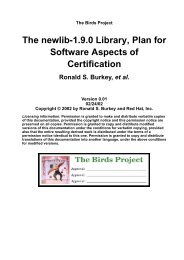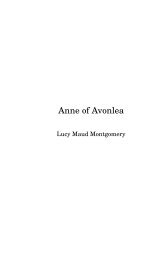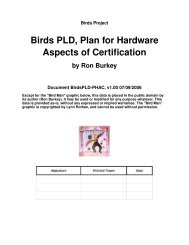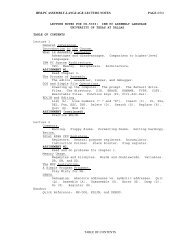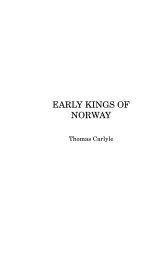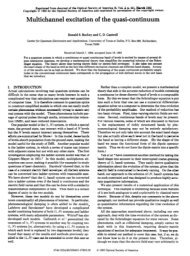Birds PLD, Plan for Hardware Aspects of Certification - Sandroid.org
Birds PLD, Plan for Hardware Aspects of Certification - Sandroid.org
Birds PLD, Plan for Hardware Aspects of Certification - Sandroid.org
Create successful ePaper yourself
Turn your PDF publications into a flip-book with our unique Google optimized e-Paper software.
<strong>Birds</strong> <strong>PLD</strong>, PHAC<br />
<strong>Birds</strong> <strong>PLD</strong>, <strong>Plan</strong> <strong>for</strong> <strong>Hardware</strong><br />
<strong>Aspects</strong> <strong>of</strong> <strong>Certification</strong><br />
by Ron Burkey<br />
Document <strong>Birds</strong><strong>PLD</strong>-PHAC, v1.00 07/09/2006<br />
Except <strong>for</strong> the "Bird Man" logo, this data is placed in the public domain by its author (Ron<br />
Burkey). It may be used or modified <strong>for</strong> any purpose whatever. This data is provided as-is, without<br />
any expressed or implied warrantee. The "Bird Man" graphic is copyrighted by Lynn Rothan, and<br />
cannot be used without permission.<br />
In<strong>for</strong>mation is subject to the<br />
restrictions on the title page 1
<strong>Birds</strong> <strong>PLD</strong>, PHAC<br />
Table <strong>of</strong> Contents<br />
1. PHAC Modification History ............................................................................................................. 3<br />
2. Purpose <strong>of</strong> PHAC Document ............................................................................................................ 3<br />
3. Documentation Traceability to DO-254 ............................................................................................... 3<br />
4. PHAC Traceability to DO-254 .......................................................................................................... 3<br />
5. System Overview ............................................................................................................................ 4<br />
5.1. System Functional Description ................................................................................................ 4<br />
5.2. System Failure Conditions ..................................................................................................... 4<br />
5.3. System Architecture .............................................................................................................. 5<br />
5.4. Allocation <strong>of</strong> Functions to <strong>Hardware</strong> and S<strong>of</strong>tware ..................................................................... 5<br />
5.5. Allocation <strong>of</strong> Safety Requirements to <strong>Hardware</strong> and S<strong>of</strong>tware ...................................................... 5<br />
5.6. Other System Documentation ................................................................................................. 5<br />
6. <strong>Hardware</strong> Overview ........................................................................................................................ 6<br />
6.1. <strong>Hardware</strong> Functional and Per<strong>for</strong>mance Requirements .................................................................. 6<br />
6.2. <strong>Hardware</strong> Reliability and Quality Requirements ......................................................................... 6<br />
6.3. <strong>Hardware</strong> Maintenance and Repair Requirements ....................................................................... 7<br />
6.4. <strong>Hardware</strong> Manufacturability and Assembly Requirements ............................................................ 7<br />
6.5. <strong>Hardware</strong> Testability Requirements ......................................................................................... 7<br />
6.6. <strong>Hardware</strong> Storage and Handling Requirements .......................................................................... 7<br />
6.7. Installation Requirements ....................................................................................................... 7<br />
6.8. <strong>Hardware</strong> Items .................................................................................................................... 7<br />
6.9. <strong>Hardware</strong> Architecture .......................................................................................................... 8<br />
6.10. New Technologies .............................................................................................................. 8<br />
6.11. Fail-Safe Techniques ........................................................................................................... 8<br />
6.12. Fault Tolerance Techniques .................................................................................................. 8<br />
6.13. Redundancy Techniques ....................................................................................................... 8<br />
6.14. Partitioning Techniques ....................................................................................................... 9<br />
7. <strong>Certification</strong> Considerations .............................................................................................................. 9<br />
7.1. Summary <strong>of</strong> the <strong>Certification</strong> Basis ......................................................................................... 9<br />
7.2. Means <strong>of</strong> Compliance ........................................................................................................... 9<br />
7.3. <strong>Hardware</strong> Level ................................................................................................................... 9<br />
7.4. Justification <strong>of</strong> <strong>Hardware</strong> Level .............................................................................................. 9<br />
8. Life Cycles .................................................................................................................................... 9<br />
8.1. <strong>Birds</strong><strong>PLD</strong> <strong>Hardware</strong> Development Life Cycle ............................................................................ 9<br />
9. Additional Considerations ............................................................................................................... 12<br />
9.1. Previously-Developed <strong>Hardware</strong> ............................................................................................ 12<br />
9.2. Commercial Off-the-Shelf <strong>Hardware</strong> ...................................................................................... 12<br />
9.3. Product Service-History ....................................................................................................... 12<br />
9.4. Tool Assessment and Qualification ........................................................................................ 12<br />
9.5. Alternative Methods <strong>of</strong> Compliance ....................................................................................... 12<br />
10. <strong>Certification</strong> Schedule .................................................................................................................. 12<br />
11. Glossary ..................................................................................................................................... 12<br />
In<strong>for</strong>mation is subject to the<br />
restrictions on the title page 2
<strong>Birds</strong> <strong>PLD</strong>, PHAC<br />
1. PHAC Modification History<br />
Revision 0.00-0.99<br />
Uncontrolled drafts.<br />
2. Purpose <strong>of</strong> PHAC Document<br />
This is a standard "<strong>Plan</strong> <strong>for</strong> <strong>Hardware</strong> <strong>Aspects</strong> <strong>of</strong> <strong>Certification</strong>" document, corresponding to the guidelines in RTCA<br />
DO-254. Among other things, it provides a system overview, a hardware overview, a description <strong>of</strong> the certification<br />
basis and justification, a description <strong>of</strong> the hardware development life cycle and data items, and a certification schedule.<br />
3. Documentation Traceability to DO-254<br />
<strong>Birds</strong><strong>PLD</strong>-PHAC <strong>Plan</strong> <strong>for</strong> <strong>Hardware</strong> <strong>Aspects</strong> <strong>of</strong> <strong>Certification</strong> DO-254 10.1.1<br />
<strong>Birds</strong><strong>PLD</strong>-HDP <strong>Hardware</strong> Design <strong>Plan</strong> DO-254 10.1.2<br />
<strong>Birds</strong><strong>PLD</strong>-HVVP <strong>Hardware</strong> Validation and Verification <strong>Plan</strong> DO-254 10.1.3 and 10.1.4<br />
<strong>Birds</strong><strong>PLD</strong>-HCMP <strong>Hardware</strong> Configuration Management <strong>Plan</strong> DO-254 10.1.5<br />
- <strong>Hardware</strong> Process Assurance <strong>Plan</strong>, not needed at assurance level<br />
C<br />
DO-254 10.1.6<br />
- Requirements Standards, not needed at assurance level C DO-254 10.2.1<br />
- <strong>Hardware</strong> Design Standards, not needed at assurance level C DO-254 10.2.2<br />
- Validation and Verification Standards, not needed at assurance<br />
level C<br />
DO-254 10.2.3<br />
- <strong>Hardware</strong> Archive Standards, not needed at assurance level C DO-254 10.2.4<br />
<strong>Birds</strong><strong>PLD</strong>-HRD <strong>Hardware</strong> Requirements Data DO-254 10.3.1<br />
<strong>Birds</strong><strong>PLD</strong>-HDRD <strong>Hardware</strong> Design Representation Data DO-254 10.3.2<br />
<strong>Birds</strong><strong>PLD</strong>-HTPR <strong>Hardware</strong> Test Processes and Results DO-254 10.4.1, 10.4.4, and<br />
10.4.5<br />
- Review Checklists DO-254 10.4.2 and 10.4.3<br />
<strong>Birds</strong><strong>PLD</strong>-VVD<br />
Validation and Verification Data (collected filled-out HTPR<br />
and Review Checklists)<br />
DO-254 10.4<br />
<strong>Birds</strong><strong>PLD</strong>-HATC <strong>Hardware</strong> Acceptance Test Criteria DO-254 10.5<br />
- Problem Reports DO-254 10.6<br />
- <strong>Hardware</strong> Configuration Management Records, combined with<br />
Validation and Verification Data (<strong>Birds</strong><strong>PLD</strong>-VVD)<br />
- <strong>Hardware</strong> Process Assurance Records, combined with Validation<br />
and Verification Data (<strong>Birds</strong><strong>PLD</strong>-VVD)<br />
DO-254 10.7<br />
DO-254 10.8<br />
<strong>Birds</strong><strong>PLD</strong>-HAS <strong>Hardware</strong> Accomplishment Summary DO-254 10.9<br />
4. PHAC Traceability to DO-254<br />
This document <strong>org</strong>anizes data in a manner consistent with DO-254 section 10.1.1, including the ordering <strong>of</strong> data and<br />
the section headings. In practice, the match is so obvious that there would be no benefit in having explicit section-bysection<br />
traceability to DO-254.<br />
In<strong>for</strong>mation is subject to the<br />
restrictions on the title page 3
<strong>Birds</strong> <strong>PLD</strong>, PHAC<br />
5. System Overview<br />
5.1. System Functional Description<br />
The system being developed is an crew-warning or annunciator system, in which activation <strong>of</strong> various electrical inputs<br />
causes annuciation <strong>of</strong> aural warnings. The system, referred to as the <strong>Birds</strong> Crew Warning System ("<strong>Birds</strong>CWS") is<br />
CPU based.<br />
However, this documentation deals only with the Programmable Logic Device (<strong>PLD</strong>) sub-system <strong>of</strong> the annunciator.<br />
The <strong>PLD</strong> sub-system, referred to as the "<strong>Birds</strong><strong>PLD</strong>", is present as a derived requirement. The <strong>Birds</strong>CWS system<br />
requirements call <strong>for</strong> the use <strong>of</strong> a hardware architecture which is reusable across differing hardware generations or<br />
even to projects other than the <strong>Birds</strong>CWS, in order to increase reusability <strong>of</strong> s<strong>of</strong>tware libraries and documentation.<br />
Thus, as a derived requirement, the <strong>Birds</strong><strong>PLD</strong> is provided to help maintain constancy <strong>of</strong> hardware/s<strong>of</strong>tware interfaces.<br />
Considered as a system <strong>of</strong> itself, the <strong>Birds</strong><strong>PLD</strong> provides the following capabilities:<br />
1. It interfaces to the CPU via the CPU's data/address bus.<br />
2. It provides an 8-bit latched parallel-data output port.<br />
3. It provides an 8-bit input parallel-data port.<br />
4. It provides a watchdog timer which can be disabled via a signal intended to be controlled by a hardware jumper.<br />
5. It provides decoding <strong>for</strong> some peripheral devices.<br />
6. It provides <strong>for</strong> flexible routing <strong>of</strong> serial data on the basis <strong>of</strong> electrical signals intended to be controlled via DIP<br />
switches.<br />
Although the <strong>Birds</strong>CWS CPU may itself have some <strong>of</strong> these facilities embedded within it, using the <strong>Birds</strong><strong>PLD</strong> rather<br />
than the embedded capabilities <strong>of</strong> the CPU allows much more flexibility in choice <strong>of</strong> CPU without s<strong>of</strong>tware change.<br />
This is because it is much easier to replace the CPU with one having a 100% compatible instruction set rather than<br />
one with 100% compatible peripheral devices.<br />
5.2. System Failure Conditions<br />
There are no identifiable failure conditions <strong>of</strong> the <strong>Birds</strong><strong>PLD</strong> sub-system.<br />
In<strong>for</strong>mation is subject to the<br />
restrictions on the title page 4
<strong>Birds</strong> <strong>PLD</strong>, PHAC<br />
5.3. System Architecture<br />
<strong>Birds</strong>CWS Block Diagram<br />
5.4. Allocation <strong>of</strong> Functions to <strong>Hardware</strong> and S<strong>of</strong>tware<br />
The <strong>Birds</strong><strong>PLD</strong> is a derived requirement, implemented entirely in hardware.<br />
5.5. Allocation <strong>of</strong> Safety Requirements to <strong>Hardware</strong> and S<strong>of</strong>tware<br />
There are no safety requirements associated with the <strong>Birds</strong><strong>PLD</strong>.<br />
5.6. Other System Documentation<br />
The <strong>Birds</strong>CWS (<strong>for</strong> which the <strong>Birds</strong><strong>PLD</strong> is a derived requirement) system requirements are described in <strong>Birds</strong> Project<br />
document <strong>Birds</strong>CWS-SCD.<br />
In<strong>for</strong>mation is subject to the<br />
restrictions on the title page 5
<strong>Birds</strong> <strong>PLD</strong>, PHAC<br />
6. <strong>Hardware</strong> Overview<br />
6.1. <strong>Hardware</strong> Functional and Per<strong>for</strong>mance Requirements<br />
6.1.1. Interface to CPU<br />
6.1.1.1. Synopsis<br />
Registers internal to the <strong>Birds</strong><strong>PLD</strong> interface to the CPU via the CPU's address/data/control bus. Each <strong>of</strong> these internal<br />
registers is 8 bits in width. A single chip-select signal from the CPU is used, and the <strong>Birds</strong><strong>PLD</strong> internally decodes 4<br />
address signals and a read/write control line to select the specific registers and the data direction.<br />
6.1.2. Parallel Output Port<br />
6.1.2.1. Synopsis<br />
The <strong>Birds</strong><strong>PLD</strong> has a single internal 8-bit register (see "Interface to CPU" above) which, upon being written to by the<br />
CPU, latches the data and delivers it to 8 discrete output pins <strong>of</strong> the <strong>Birds</strong><strong>PLD</strong>. The register may also be read by the<br />
CPU, in which case the contents <strong>of</strong> the latch are returned.<br />
6.1.3. Parallel Input Port<br />
6.1.3.1. Synopsis<br />
The <strong>Birds</strong><strong>PLD</strong> has an 8-bit register (see "Interface to CPU" above) which can be interrogated by the CPU to determine<br />
the state <strong>of</strong> 8 discrete input signals to the <strong>Birds</strong><strong>PLD</strong>.<br />
6.1.4. Watchdog Timer<br />
6.1.4.1. Synopsis<br />
The <strong>Birds</strong><strong>PLD</strong> implements a watchdog timer circuit which must be refreshed periodically or else it times out and<br />
generates an output signal intended to be used as a system reset. Refreshing the watchdog involves the CPU writing<br />
two predetermined valued to two internal 8-bit registers (see "Interface to CPU" above) <strong>of</strong> the <strong>Birds</strong><strong>PLD</strong>.<br />
6.1.5. Peripheral Address Decoder<br />
6.1.5.1. Synopsis<br />
The <strong>Birds</strong><strong>PLD</strong> provides address decoding <strong>for</strong> 8 peripheral devices external to the CPU and <strong>Birds</strong><strong>PLD</strong>. It employs the<br />
same chip-select as <strong>for</strong> "Interface to CPU" above, conditions that chip-select by detecting that the address lines are in<br />
8 different address ranges, and outputs 8 sets <strong>of</strong> control signals.<br />
6.1.6. Serial Data Routing<br />
6.1.6.1. Synopsis<br />
The <strong>Birds</strong><strong>PLD</strong> accepts 4 serial-data signals as inputs and outputs 4 serial-data signals as outputs. For each <strong>of</strong> the 4<br />
outputs, there are 2 input signals determining which <strong>of</strong> the 4 inputs is routed to the output.<br />
6.2. <strong>Hardware</strong> Reliability and Quality Requirements<br />
None.<br />
In<strong>for</strong>mation is subject to the<br />
restrictions on the title page 6
<strong>Birds</strong> <strong>PLD</strong>, PHAC<br />
6.3. <strong>Hardware</strong> Maintenance and Repair Requirements<br />
None.<br />
6.4. <strong>Hardware</strong> Manufacturability and Assembly Requirements<br />
None.<br />
6.5. <strong>Hardware</strong> Testability Requirements<br />
None.<br />
6.6. <strong>Hardware</strong> Storage and Handling Requirements<br />
None.<br />
6.7. Installation Requirements<br />
None.<br />
6.8. <strong>Hardware</strong> Items<br />
6.8.1. <strong>Birds</strong><strong>PLD</strong><br />
The sole hardware item covered by this documentation is the <strong>Birds</strong><strong>PLD</strong> itself.<br />
In<strong>for</strong>mation is subject to the<br />
restrictions on the title page 7
<strong>Birds</strong> <strong>PLD</strong>, PHAC<br />
6.9. <strong>Hardware</strong> Architecture<br />
6.10. New Technologies<br />
None.<br />
6.11. Fail-Safe Techniques<br />
None.<br />
6.12. Fault Tolerance Techniques<br />
None.<br />
6.13. Redundancy Techniques<br />
None.<br />
<strong>Birds</strong><strong>PLD</strong> Block Diagram<br />
In<strong>for</strong>mation is subject to the<br />
restrictions on the title page 8
<strong>Birds</strong> <strong>PLD</strong>, PHAC<br />
6.14. Partitioning Techniques<br />
Each function <strong>of</strong> the <strong>Birds</strong><strong>PLD</strong> is implemented at a DO-254 assurance level <strong>of</strong> C. Thus there is no partitioning <strong>of</strong><br />
assurance levels.<br />
7. <strong>Certification</strong> Considerations<br />
7.1. Summary <strong>of</strong> the <strong>Certification</strong> Basis<br />
Please reference the documentation <strong>of</strong> the parent <strong>Birds</strong>CWS project (<strong>Birds</strong>CWS-PHAC).<br />
7.2. Means <strong>of</strong> Compliance<br />
RTCA DO-254 is used as the means <strong>of</strong> compliance, per FAA AC20-152.<br />
7.3. <strong>Hardware</strong> Level<br />
The assurance level is C. (Refer to RTCA DO-254, Table 2-1.)<br />
7.4. Justification <strong>of</strong> <strong>Hardware</strong> Level<br />
Please reference the documentation <strong>of</strong> the parent <strong>Birds</strong>CWS project (<strong>Birds</strong>CWS-PHAC).<br />
8. Life Cycles<br />
8.1. <strong>Birds</strong><strong>PLD</strong> <strong>Hardware</strong> Development Life Cycle<br />
8.1.1. Life-Cycle<br />
8.1.1.1. Processes<br />
The <strong>Hardware</strong> Design <strong>Plan</strong> (HDP) describes the life-cycle processes in detail. What follows is a brief summary.<br />
The canonical life-cycle processes envisaged by DO-254 Chapter 3 are used. The following processes occur in sequential<br />
order:<br />
• <strong>Plan</strong>ning Process<br />
• Requirements Capture Process, wherein system requirements are allocated to hardware requirements, and traceability<br />
between system requirements and hardware requirements is established.<br />
• Conceptual Design Process, wherein hardware requirements are developed in detail.<br />
• Detailed Design Process, wherein specific design artifacts such as schematic captures, bills <strong>of</strong> material, or HDL<br />
source code are developed from the conceptual design data.<br />
• Implementation Process, wherein detailed design data is converted to physical hardware such as circuit boards or<br />
ASICs.<br />
• Validation and Verification Process. The "validation" portion <strong>of</strong> this process actually is concurrent with all other<br />
process, and only the "verification" part is sequential. However, validation occurs by means <strong>of</strong> review checklists<br />
called out by process checklists <strong>of</strong> the other processes. In other words, validation is really integrated with other<br />
processes rather than being a separate process <strong>of</strong> itself.<br />
In<strong>for</strong>mation is subject to the<br />
restrictions on the title page 9
<strong>Birds</strong> <strong>PLD</strong>, PHAC<br />
• Product Transition Process, wherein manufacturing and repair data is created, traceability with detailed design data<br />
is established, and acceptance occurs.<br />
The following processes are concurrent with the sequential processes:<br />
• <strong>Hardware</strong> Configuration Management Process<br />
• <strong>Hardware</strong> Process Assurance<br />
• <strong>Certification</strong> Liaison Process<br />
8.1.1.2. Process Procedures<br />
The <strong>Hardware</strong> Design <strong>Plan</strong> (HDP) describes the process procedures in detail. What follows is a brief summary.<br />
Each <strong>of</strong> the hardware life-cycle process (<strong>Plan</strong>ning, Requirements Capture, etc.) has an associated checklist which<br />
itemizes each <strong>of</strong> the steps required to complete that process. The checklists are separate documents, called out in the<br />
<strong>Hardware</strong> Development <strong>Plan</strong> (HDP). The checklists include not only the steps specific to the associated processes,<br />
but also all <strong>of</strong> the Validation Process, <strong>Hardware</strong> Configuration Management Process, and <strong>Certification</strong> Liaison steps<br />
which are relevant, thus obviating most <strong>of</strong> the need <strong>for</strong> separate Validation, <strong>Hardware</strong> Configuration Management, and<br />
<strong>Certification</strong> Liaison Processes. Additionally, the checklists contain some, but not all, associated <strong>Hardware</strong> Process<br />
Assurance tasks.<br />
At the outset <strong>of</strong> any given life-cycle process, the lead hardware developer obtains a blank copy <strong>of</strong> the process checklist.<br />
As each step <strong>of</strong> the process is per<strong>for</strong>med, the he/she initials and dates that step. When all steps are complete, or when<br />
a regression is made to an earlier life-cycle process, the completed process becomes part <strong>of</strong> the <strong>Hardware</strong> Process<br />
Assurance Records (HPAR), which <strong>for</strong> this project are combined with the Validation and Verification Data (VVD).<br />
When a regression to an earlier life-cycle process is made, the lead developer obtains a new, blank copy <strong>of</strong> the earlier<br />
life-cycle process.<br />
Blank life-cycle process checklists are reviewed and approved, prior to use, by the lead hardware developer. In case<br />
the life-cycle processes are identical to those in previously-developed hardware at the same assurance level, process<br />
checklists from the prior project can be used unchanged.<br />
<strong>Hardware</strong> Process Assurance (HPA) differs from the other life-cycle processes, in that it does not have a process<br />
checklist. Rather the process checklists lists all relevant HPA tasks. Since DO-254 does not require <strong>for</strong>mal HPA at<br />
assurance level C, all HPA activities are per<strong>for</strong>med by the lead hardware developer.<br />
8.1.1.3. <strong>Hardware</strong> Design Methods<br />
<strong>Hardware</strong> requirements, design, test procedures, and configuration data are captured and interrelated using a s<strong>of</strong>tware<br />
tool called Do178Builder.<br />
Conceptual design data is converted to detailed design data by creating VHDL source code, and then compiling that<br />
code using tools provided by the manufacturer <strong>of</strong> the <strong>PLD</strong> device used.<br />
8.1.1.4. Process Standards<br />
None.<br />
8.1.1.5. Activities<br />
The activities are defined by the <strong>Hardware</strong> Design <strong>Plan</strong> (<strong>Birds</strong><strong>PLD</strong>-HDP). In brief, each development process (<strong>Plan</strong>ning,<br />
Requirements Capture, Conceptual Design, etc.) has an associated checklist <strong>of</strong> activities, managed by the lead<br />
In<strong>for</strong>mation is subject to the<br />
restrictions on the title page 10
<strong>Birds</strong> <strong>PLD</strong>, PHAC<br />
hardware developer. The checklist <strong>for</strong> each development process is completed be<strong>for</strong>e proceeding to the next development<br />
process. The process checklists include: development <strong>of</strong> data items, review and release <strong>of</strong> data items, etc.<br />
8.1.1.6. Organizational Responsibilities<br />
The <strong>Birds</strong><strong>PLD</strong> is solely developed by Ron Burkey <strong>of</strong> the <strong>Birds</strong> Project.<br />
8.1.2. Life-Cycle Data<br />
8.1.2.1. Data Items<br />
<strong>Birds</strong><strong>PLD</strong>-<br />
PHAC<br />
<strong>Plan</strong> <strong>for</strong> <strong>Hardware</strong> <strong>Aspects</strong> <strong>of</strong> <strong>Certification</strong> <strong>Plan</strong>ning Submit<br />
<strong>Birds</strong><strong>PLD</strong>-HDP <strong>Hardware</strong> Design <strong>Plan</strong> <strong>Plan</strong>ning Records<br />
<strong>Birds</strong><strong>PLD</strong>-<br />
HVVP<br />
<strong>Hardware</strong> Validation and Verification <strong>Plan</strong> <strong>Plan</strong>ning Submit<br />
<strong>Birds</strong>-HCMP <strong>Hardware</strong> Configuration Management <strong>Plan</strong> <strong>Plan</strong>ning Records<br />
- Note that a <strong>Hardware</strong> Process Assurance <strong>Plan</strong> is not<br />
needed at assurance level C.<br />
- Note that Requirements Standards are not needed at<br />
assurance level C.<br />
- Note that <strong>Hardware</strong> Design Standards are not needed<br />
at assurance level C.<br />
- Note that Validation and Verification Standards are<br />
not needed at assurance level C.<br />
- Note that <strong>Hardware</strong> Archive Standards are not needed<br />
at assurance level C.<br />
- Not used<br />
- Not used<br />
- Not used<br />
- Not used.<br />
- Not used.<br />
<strong>Birds</strong><strong>PLD</strong>-HRD <strong>Hardware</strong> Requirements Data Requirements Capture Records<br />
<strong>Birds</strong><strong>PLD</strong>-<br />
HDRD<br />
<strong>Hardware</strong> Design Representation Data Conceptual Design Records<br />
- Detailed Design Data Detailed Design Submit top-level<br />
drawing only<br />
<strong>Birds</strong><strong>PLD</strong>-HT-<br />
PR<br />
<strong>Hardware</strong> Test Processes and Results Verification Records<br />
<strong>Birds</strong><strong>PLD</strong>-VVD Validation and Verification Data<br />
Validation and Verification<br />
<strong>Birds</strong><strong>PLD</strong>-<br />
HATC<br />
Records<br />
<strong>Hardware</strong> Acceptance Test Criteria Verification Records<br />
<strong>Birds</strong><strong>PLD</strong>-HAS <strong>Hardware</strong> Accomplishment Summary Product Transition Submit<br />
- <strong>Hardware</strong> Configuration Management Records are<br />
combined with the Validation and Verification Data<br />
(<strong>Birds</strong><strong>PLD</strong>-VVD)<br />
Manage-<br />
Configuration<br />
ment<br />
- <strong>Hardware</strong> Process Assurance Records are combined Process Assurance<br />
with the Validation and Verification Data (<strong>Birds</strong><strong>PLD</strong>-<br />
VVD)<br />
Records<br />
Records<br />
In<strong>for</strong>mation is subject to the<br />
restrictions on the title page 11
<strong>Birds</strong> <strong>PLD</strong>, PHAC<br />
9. Additional Considerations<br />
9.1. Previously-Developed <strong>Hardware</strong><br />
None. Note that the <strong>Birds</strong><strong>PLD</strong> is being developed in a manner that presumes it will eventually be possible to use it<br />
as previously-developed hardware in other projects.<br />
9.2. Commercial Off-the-Shelf <strong>Hardware</strong><br />
None.<br />
9.3. Product Service-History<br />
None.<br />
9.4. Tool Assessment and Qualification<br />
Outputs <strong>of</strong> all tools are checked as part <strong>of</strong> the Verification Process, and there<strong>for</strong>e the tools themselves do not need<br />
qualification.<br />
Note, however, that the traceability data is automatically generated by the documentation tool (Do178Builder) used to<br />
manage the requirements, the design data, and the test procedures, and that it would be very convenient to be able to use<br />
this data as-is without the burden <strong>of</strong> having to check it. Since the Do178Builder tool is not qualified <strong>for</strong> this purpose<br />
initially, manual checks <strong>of</strong> the traceability data will have to be made <strong>for</strong> the initial release <strong>of</strong> the <strong>Birds</strong><strong>PLD</strong>. However,<br />
this initial check shall qualify the Do178Builder tool (in the version used <strong>for</strong> the initial release) <strong>for</strong> generation <strong>of</strong><br />
traceability data in later releases <strong>of</strong> the <strong>Birds</strong><strong>PLD</strong> or other <strong>Birds</strong> Projects hardware development.<br />
9.5. Alternative Methods <strong>of</strong> Compliance<br />
No methods <strong>of</strong> compliance other than those <strong>of</strong> DO-254 are used.<br />
10. <strong>Certification</strong> Schedule<br />
Reference the documentation <strong>of</strong> the parent project (<strong>Birds</strong>CWS-PHAC). Activities related solely to the <strong>Birds</strong><strong>PLD</strong> subproject<br />
are as follows.<br />
Date Milestone Comment<br />
August 2006<br />
September 2006<br />
October 2006<br />
November 2006<br />
December 2006<br />
January 2007<br />
February 2007<br />
11. Glossary<br />
DER accepts PHAC<br />
HDP, HVVP, HCMP ready<br />
HRD, HDRD ready<br />
Detailed design and implementation complete<br />
Test procedures (HTPR) complete<br />
Testing complete<br />
DER sign<strong>of</strong>f, <strong>Birds</strong><strong>PLD</strong> released<br />
ASIC. Application Specific Integrated Circuit.<br />
In<strong>for</strong>mation is subject to the<br />
restrictions on the title page 12
<strong>Birds</strong> <strong>PLD</strong>, PHAC<br />
CAD. Computer Aided Design.<br />
CAM. Computer Aided Manufacturing.<br />
COTS. Commercial Off-The-Shelf.<br />
C<strong>PLD</strong>. Complex Programmable Logic Device.<br />
DER. Designated Engineering Representative.<br />
FAA. Federal Aviation Administration.<br />
FPGA. Field Programmable Gate Array.<br />
HARS. <strong>Hardware</strong> Archiving Standards.<br />
HATC. <strong>Hardware</strong> Acceptance Test Criteria.<br />
HAS. <strong>Hardware</strong> Accomplishment Summary.<br />
HC1 and HC2. <strong>Hardware</strong> Control Categories 1 and 2.<br />
HCM. <strong>Hardware</strong> Configuration Management.<br />
HCMP. <strong>Hardware</strong> Configuration Management <strong>Plan</strong>.<br />
HCMR. <strong>Hardware</strong> Configuration Management Records.<br />
HDL. <strong>Hardware</strong> Description Language or <strong>Hardware</strong> Design Language. For example, Verilog, VHDL, Abel.<br />
HDP. <strong>Hardware</strong> Design <strong>Plan</strong>.<br />
HDRD. <strong>Hardware</strong> Design Representation Data.<br />
HDS. <strong>Hardware</strong> Design Standards.<br />
HPA. <strong>Hardware</strong> Process Assurance.<br />
HPAP. <strong>Hardware</strong> Process Assurance <strong>Plan</strong>.<br />
HPAR. <strong>Hardware</strong> Process Assurance Records.<br />
HRD. <strong>Hardware</strong> Requirements Data.<br />
HTPR. <strong>Hardware</strong> Test Procedures and Results.<br />
HVVP. <strong>Hardware</strong> Validation and Verification <strong>Plan</strong>.<br />
ICD. Interface Control Drawing.<br />
LRU. Line Replaceable Unit.<br />
PCB. Printed Circuit Board. Same as PWB. I.e., a "bare" circuit board as fabricated, prior to assembly with electronic<br />
components.<br />
PHAC. <strong>Plan</strong> <strong>for</strong> <strong>Hardware</strong> <strong>Aspects</strong> <strong>of</strong> <strong>Certification</strong>.<br />
In<strong>for</strong>mation is subject to the<br />
restrictions on the title page 13
<strong>Birds</strong> <strong>PLD</strong>, PHAC<br />
<strong>PLD</strong>. Programmable Logic Device.<br />
PR. Problem Report(s).<br />
PWA. Printed Wire Assembly. I.e., a PCB or PWB after assembly with electronic components.<br />
PWB. Printed Wire Board. Same as PCB. I.e., a "bare" circuit board as fabricated, prior to assembly with electronic<br />
components.<br />
RTCA. Once upon a time, Radio Technical Commission <strong>for</strong> Aeronautics. Now, apparently, simply "RTCA, Inc."<br />
without being intended as an acronym.<br />
SCD. Specification Control Drawing.<br />
RS. Requirements Standards.<br />
VVS. Validation and Verification Standards.<br />
In<strong>for</strong>mation is subject to the<br />
restrictions on the title page 14



